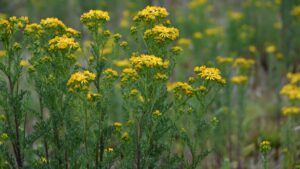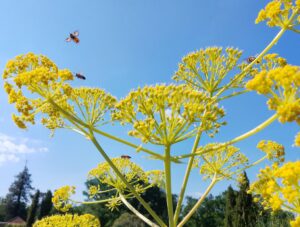
Podcast Episode 36 – The Dove From Above
PODCAST EPISODE 36: The Dove From Above Join us on a beautiful June evening for episode 36 of the Knepp Wildland Podcast. We’re joined by
Home / The Journey to Wilding the Garden ~ August 2020
The month began with heat, and escalated to more new records; as I climbed into my stifling car at the end of one day the digital display showed thirty-five degrees. In the garden leaves sagged with despondent shoulders, the Hyssop looked as though it had already been cut and dried for the kitchen. A fine gauzy film seemed to cover your view; the whole palette of the garden resembled the faded hues of a much loved and over washed once-green shirt.
![The dark pink fruits of the Szechuan pepper [Zanthoxylum simulans], native to Eastern China and Taiwan.](https://knepp.co.uk/wp-content/uploads/2022/10/AugSzechuanpepper228129.jpg)
The dark pink fruits of the Szechuan pepper [Zanthoxylum simulans], native to Eastern China and Taiwan.
The new planting showed surprising resilience; those from 9cm pots had quickly established and were providing enough foliage to act as mulch and moisture retainers. Those that needed more attention were the bigger shrubs and trees. We were a little concerned about the Szechuan pepper, [Zanthoxylum simulans], native to Eastern China and Taiwan. We were pleased to notice that the dark pink fruits were splitting open like a fish mouth holding a shiny black seed about the size of a ball bearing. Jekka McVicar had written to us, “[they are] fascinating, pollination is done in a day, the bees come just for the day so your crop is totally weather dependent. … You only eat the outer casing not the seed…. try the casing fresh, it is amazing, starts off with a citrus flavour, then makes your whole mouth zing.” Eager to try, our faces transformed to one of a small child being given a lemon for the first time. The sensation of our mouth, lips and tongue emerging from numbness after a strong anesthetic wore off after a half hour or so. No one else seemed too keen to join the experience, so we are drying the fruits on sheets of paper as advised and will pass on some to Ian to try in the meat rubs and sausages of the wildland meat range.

Lemon Drop chilli from Peru
Suzi’s selection of chillis have been a great success in the greenhouse although we’ve yet to cook with some of the milder varieties: Poblano from Mexico that turns from green to dark red, Lemon Drop from Peru, bright yellow with a citrus flavour and Banana peppers, named for their resemblance in colour and shape that are milder and sweeter than jalapeños. The roller coaster emotional ride that is vegetable growing means looking at the rocket salad in the raised beds, with their thousand tiny holes from a flea beetle infestation making you want to weep, and moments later braiding a string of silk-paper clad onions so beautiful you’re filled with motherly pride. The yellow cannonball courgette, ‘Florido‘ seems to have thrived in the heat and dryness, reaching football like dimensions if left to its own devices within a few days. Winter salads, fennel, cabbage, spinach, carrots, dill and coriander seeds have all been sown, and it seems incredible that Autumn is already waiting in the wings.

The Wisteria covering the front of the Castle
The second week saw us up the cherry picker, fourteen metres above ground, curbing the enthusiasm of the summer growth on the Wisteria that cloaks the front of the castle and the library. A quantity of accumulated dead material had been taken out two years ago, and last summer we made some inroads into bringing back the protruding stems, halving the two metre overhang. This year our focus was on taking out the often-frenzied growth around the fifteen windows that regularly threatens to obscure the view. There’s no guarantee that the plant will behave exactly as you envisage; there’s always a leap of faith until you see the fruits of your labours the following season. We had forgotten the curious sensation of having been on a boat after a day in the airborne platform, the bobbing movement continuing well after you become earthbound.
Bryn Thomas from the Brighton Permaculture Trust arrived to pick apples for juicing; unlike last year, this season’s crop is fantastic, many trees dripping with fruit. We’ve summer and winter pruned the trees, set up sturdy rabbit guards, and kept down the nettles round the bases with mulches and regular strimming, so we were pleased to see the ample crop. Since ours is a successional orchard, Bryn took the early ripening fruit to produce pasteurised bottles for the campsite shop, and we’ll pick later varieties for eating and pulping in September. Suzi nearly came a cropper picking from the top of a ladder in the old chicken coop. A buzzard had evidently found a secluded lunch spot in the roost house and, startled by the disturbance, broke cover at speed and almost toppled her with its wingspan of over a metre.
Finally, the weather broke and Storm Francis hit the UK, the only second named storm ever to be recorded in August. Fifty mile an hour winds raged through the garden and rain fell, impenetrable and relentless. Longed for, but barely scratching the surface as far as the water table was concerned. Our own impact on climate change is undoubtedly complex, but evidence of change, of new records being made every month is undeniable. It’s easy to become overwhelmed, but in the same way changes in weather are incremental, we’ve seen that those small plants in 9cm pots have rooted and settled in just a few months, spread to nestle against their neighbours, every one its own oxygen making, CO2 processing factory. Gardens, however small, are synonymous with hope.
Moy Fierheller Joint Head Gardener August 2020
What we are reading:
Elaine Ingham Investing in Regenerative Agriculture and Food

PODCAST EPISODE 36: The Dove From Above Join us on a beautiful June evening for episode 36 of the Knepp Wildland Podcast. We’re joined by

Matt Phelps | Lead Ecologist It’s mid-June and the countryside is quietly gearing up for its summer crescendo. You might have noticed it already— what

Moy Fierheller | Deputy Head Gardener Visit Knepp’s rewilded Walled Garden The fine, fairy-tale spring continues and the Met Office reports it’s the sunniest in
Knepp Wildland Safaris, our gardens and campsite are all about the quiet and patient observation of nature.
Some of the species we are likely to encounter are shy or can be frightened by loud noises or sudden movements. Our campsite with open-air fire-pits, wood-burning stoves and an on-site pond is unsuitable for small children.
For this reason, our safaris, garden visits, holiday cottages and campsite are suitable only for children of 12 and over.